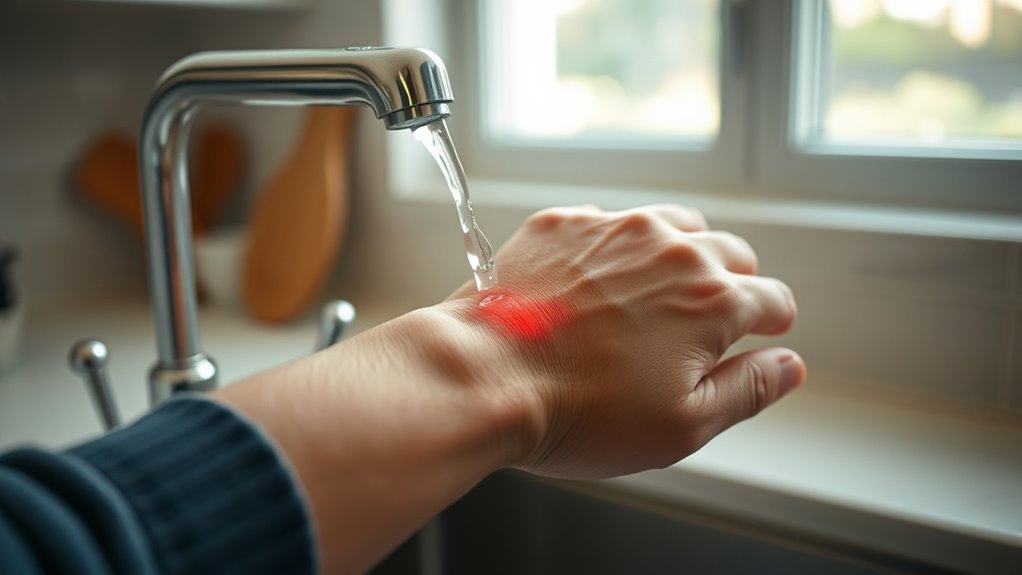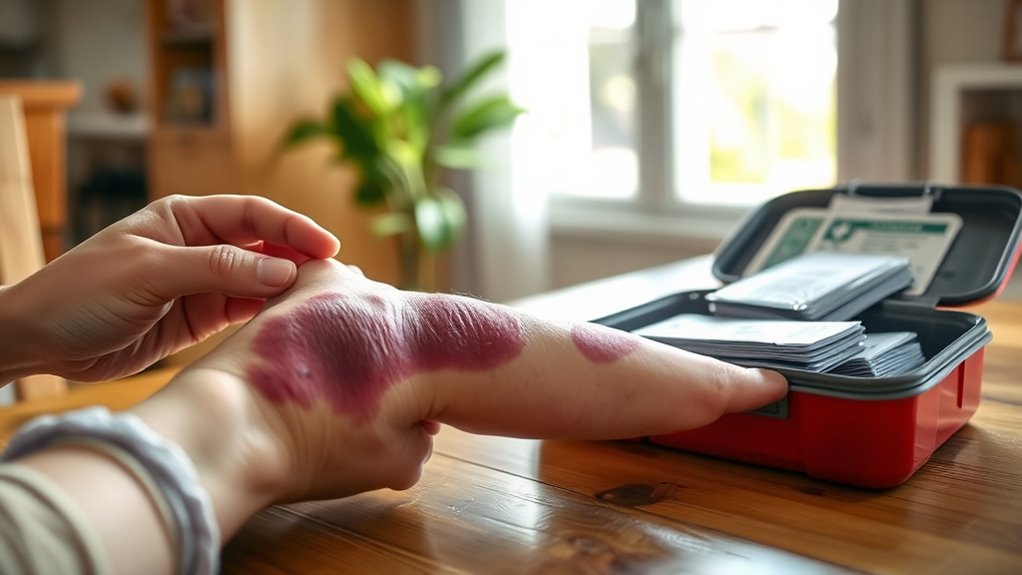To handle common emergencies at home, start by ensuring the scene is safe before helping others. Learn basic first aid skills like cleaning wounds, applying dressings, and stopping bleeding. Know how to cool burns, recognize choking signs, and perform CPR if needed. Using an AED can also save lives in emergencies. Mastering these essential steps can make all the difference—keep exploring to get fully prepared for any situation.
Key Takeaways
- Ensure scene safety and call emergency services before assisting.
- Use sterile techniques to clean and dress wounds to prevent infection.
- Cool burns immediately with running cold water and cover with sterile bandages.
- Recognize choking signs and perform abdominal thrusts or CPR if needed.
- Identify serious injuries early and use AED and CPR to improve survival chances.
Assessing the Situation Safely

Before approaching an injured person, you need to evaluate the scene to make certain it’s safe for you to help. Your first step is ensuring scene safety, which involves checking for hazards like fire, downed power lines, or unstable structures. This is part of your emergency assessment—quickly evaluating the environment to identify potential dangers. If the scene isn’t safe, don’t enter; instead, call emergency services and wait for professionals. Always look for clues that might indicate ongoing dangers, such as spilled chemicals or aggressive individuals. Once the scene is confirmed safe, you can proceed with providing aid. Remember, rushing in without assessing the scene could put both you and the victim at risk. Stay alert, stay safe, and prioritize scene safety above all.
Basic Wound Care and Infection Prevention

Once you’ve confirmed the scene is safe, you can focus on caring for the injured person’s wounds. To prevent wound infection, it’s vital to use sterile technique. Start by washing your hands thoroughly or wearing disposable gloves if available. Clean the wound gently with clean water to remove dirt and debris—avoid using harsh antiseptics that can damage tissue. Apply gentle pressure with a clean cloth or sterile dressing to stop bleeding. Once the bleeding slows, cover the wound with a sterile bandage or dressing. Maintaining a sterile environment reduces the risk of wound infection, which can cause complications or delay healing. Using proper wound dressing techniques further helps protect the wound from infection. If the wound appears deep or shows signs of infection, seek medical attention promptly. Proper wound care is essential for safe healing. Additionally, understanding infection prevention strategies can help minimize complications, including the use of sterile techniques to reduce contamination risks.
Managing Burns and Scalds

Have you ever wondered what to do immediately after someone sustains a burn or scald? Recognizing burn severity is essential to providing proper care. First, remove the person from the hot liquid hazard or source of heat. Then, follow these steps:
- Cool the burn with running cold water for at least 10 minutes to reduce heat and pain.
- Avoid applying ice or ointments, which can worsen tissue damage.
- Cover the burn with a sterile, non-stick bandage to prevent infection.
- Seek medical attention if the burn is deep, larger than 3 inches, or involves the face, hands, or genitals.
- Be aware that dog names can reflect personality traits, which might influence how you care for a pet with injuries like burns.
Prompt action can minimize damage and manage pain effectively. Remember, quick response is critical in burns to prevent complications.
Handling Choking and Breathing Emergencies

Handling choking and breathing emergencies requires quick, decisive action to prevent serious injury or death. Child safety is especially important, as children are more prone to choking hazards. If someone is choking, encourage them to cough and if they can’t breathe, perform abdominal thrusts (Heimlich maneuver) to dislodge the object. Always stay calm and act swiftly. In breathing emergencies, check for responsiveness and call 911 immediately. If necessary, provide CPR until help arrives. Fire prevention also plays a role in overall safety; keep small objects out of children’s reach and ensure smoke alarms are working. Practicing these first aid steps can make a critical difference, protecting your loved ones during emergencies and supporting a safer home environment.
Recognizing Signs of Serious Injuries

Recognizing the signs of serious injuries is vital for providing effective help and preventing further harm. Common injury symptoms and emergency response signs can indicate when immediate medical attention is needed. Look for:
- Severe pain or intense bleeding that doesn’t stop
- Loss of consciousness or confusion
- Unnatural movements or inability to move limbs
- Visible deformities or swelling, indicating broken bones
These symptoms often signal the need for urgent care. If you notice any of these signs, don’t delay—call emergency services immediately. Acting quickly can prevent complications and save lives. Always trust your instincts; if something feels wrong, it’s better to be safe and seek professional help. Recognizing these key signs ensures you respond appropriately during emergencies.
Performing CPR and Using an AED

When someone’s heart stops beating or they stop breathing, performing CPR and using an AED can be life-saving actions. Begin by calling emergency services and checking for responsiveness. If needed, start CPR using proper techniques: push hard and fast in the center of the chest at a rate of about 100-120 compressions per minute, allowing the chest to fully recoil. If an AED is available, turn it on and follow its prompts for AED operation. It will analyze the person’s heart rhythm and advise if a shock is needed. Clear the victim during analysis and shock delivery. Continuing CPR with proper technique maximizes the chances of survival. Proper training can improve the effectiveness of your response in emergencies. Knowing these CPR techniques and AED operation can make a vital difference in an emergency. Additionally, understanding the divorce process in your state can help individuals navigate legal proceedings more effectively when needed. Staying informed about AI-powered medical tools can also enhance emergency response and patient outcomes. Being familiar with holistic wellness approaches can further support overall recovery after emergency events.
Creating a Home First Aid Kit

Creating a well-stocked home first aid kit is essential for quickly addressing minor injuries and emergencies. Proper first aid kit organization guarantees that supplies are easy to find when needed. Start by including these key items:
- Bandages, gauze, and adhesive tape for cuts and scrapes
- Antiseptic wipes and ointments to prevent infection
- Tweezers and scissors for splinters or clothing removal
- An emergency contact list with local numbers and healthcare providers
Keep the kit in a designated, accessible spot and regularly check supplies for expiration. Ensure your emergency contact list is up to date and stored within easy reach. A well-organized kit helps you respond swiftly and confidently during urgent moments.
Frequently Asked Questions
How Often Should I Update My Home First Aid Kit?
You should update your home first aid kit regularly to make certain it’s ready when needed. For first aid maintenance, check your kit at least every six months, and after any use. Replenish supplies like bandages, antiseptics, and medications as needed to prevent expiration or shortages. Keeping your kit current guarantees you’re prepared for emergencies, providing peace of mind and effective response during unexpected injuries.
What Are Common First Aid Mistakes to Avoid?
Like a knight of old, you must avoid common first aid mistakes to protect your household. Be cautious of medication errors—double-check dosages and never share meds. Improper bandaging can worsen injuries or cause infections, so learn proper techniques. Rushing or panicking may lead to overlooking critical steps. Staying calm, informed, and attentive helps you provide effective care, preventing small issues from turning into bigger emergencies.
When Should I Seek Professional Medical Help Immediately?
You should seek professional medical help immediately when you notice emergency signs such as severe bleeding, chest pain, difficulty breathing, loss of consciousness, or signs of stroke. When these occur, don’t hesitate—call 911 right away. Knowing when to call 911 guarantees you get urgent care quickly, which can be lifesaving. Trust your instincts; if a situation feels serious, it’s better to be safe and get expert help promptly.
Can I Use Home Remedies for Wound Care?
You might consider natural remedies or herbal applications for minor wounds, but caution is key. While some herbs like honey or aloe vera can soothe and promote healing, they shouldn’t replace proper wound care. Always clean the wound thoroughly first. If you notice signs of infection, deep cuts, or if the wound doesn’t heal, seek professional medical help immediately. Never rely solely on home remedies for serious or contaminated wounds.
How Can I Train Family Members in First Aid Effectively?
They say, “Practice makes perfect,” and that’s true for training your family in first aid. You should involve everyone’s family role in emergency practice sessions, making them interactive and engaging. Use real-life scenarios to boost confidence and guarantee everyone knows what to do. Regular drills help ingrain skills and reduce panic. Keep training simple, fun, and consistent, so your loved ones are prepared when it counts most.
Conclusion
Being prepared with these first aid basics can make all the difference in emergencies. You don’t need to be a medical expert—just knowing how to respond can save lives. Are you ready to confidently handle common injuries and emergencies at home? Keep your first aid kit stocked and practice these skills regularly. The more prepared you are, the safer your home will be for everyone you love.










